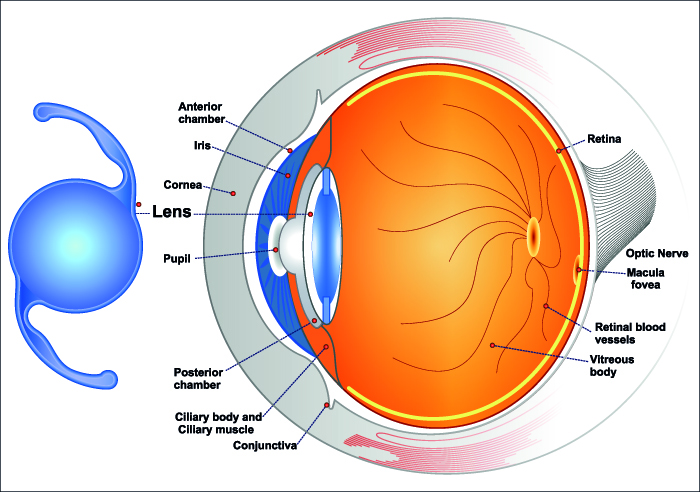IOL Surgery Treatment & Diagnostics in Sadashiv Peth, Pune
IOL Surgery
A part of cataract surgery, an Intraocular lens (IOL) refers to an artificial lens that is used to replace the original lens of the eyes. IOL surgery is a part of surgery performed to fix cataracts. The eyes consist of a lens that is made up of water and clear protein that sits behind the pupil. With age, the proteins change and this change may lead to hazy or blurred vision by turning parts of the lens cloudy. This condition is known as a cataract. Cataracts can lead to blindness. The intraocular lens is used to correct vision. An intraocular lens (IOL) implant can be made out of silicon, plastic, or acrylic and holds the size of about a third of the dime. It is coated with a special material that helps to protect the eyes from harmful ultraviolet (UV) rays.

Intraocular lens (IOL) can be of different types:
- Monofocal IOL: this is the most common type of IOL used which remains focused at a fixed distance. This aids the eyesight to see things that are far away but glasses are needed to read up close.
- Multifocal IOL: this lens aids to see things at different distances. Although, the brain may take time to adapt to get natural vision.
- Accommodating IOL: more like a natural lens, accommodating lens can focus on more than one distance.
- Toric IOL: this is needed with astigmatism or cornea.
When do you need an IOL surgery?
The signs that may indicate the need for IOL surgery are listed below:
- Blurred or hazy vision
- Halos visible around light
- Fading colors
- Eyesight turning yellowish
- Clouded of dim vision
- Double vision in a single eye
- Frequent variation in the prescribed eyeglasses or lenses
- Need for more light during reading
- Eye sensitivity to light
If you observe the above symptoms, you must see a doctor.
Request an appointment at Apollo Spectra Hospitals, Pune
Call 1860-500-2244 to book an appointment
How is the IOL surgery performed?
To initiate the process of IOL surgery, the ophthalmologist, a doctor who has specialized in eye problems and eye surgery, may measure your eyes to choose the right implant. He may refer you to certain medicated eye drops to use for a few days before the surgery takes place. The ophthalmologist may also prescribe certain medicines that are to be taken beforehand.
The different steps in the IOL surgery are listed as follows:
- The surgeon may numb the eye before the surgery begins.
- Certain medicated drugs may be given to avoid the pain and any feeling of pressure.
- A tiny cut is made through the cornea of the eye to reach the lens.
- The lens is broken up into several tiny pieces and thereafter, removed bit by bit.
- The IOL implant is then put in its place.
- The cut is allowed to heal itself naturally and no stitches are required to put it into place.
- The redness or swelling of the eye is common after the surgery. And it may take 8 to 12 weeks to fully recover.
What measures should be taken after the surgery?
The certain measure should be taken to protect the operated eye:
- Sunglasses should be worn at all times to protect the eye from the sun or dust.
- The eye should not be rubbed or pressed.
- The prescribed medical eye drops should be used on schedule every day.
- Heavy exercises and lifting should be avoided.
What are the complications involved with IOL surgery?
Even though the complications involved in the IOL surgery are rare, a person may notice bleeding or catch an infection after the surgery. There are also certain risks like loss of vision, detached retina, dislocation, or after-cataract that are involved with the IOL surgery.
What measures you should take to maintain healthy eyesight?
Certain preventions can be maintained by an individual on his own to maintain healthy eyesight can be as follows:
- Regular eye examinations should be scheduled to keep in check the eye health
- Smoking may also affect the health of the eyes, hence should be avoided.
- A diet loaded with fruits and vegetables should be followed.
- Too much exposure to sunlight may also harm the eyes.
- A person suffering from diabetes or other medical condition may be more prone to a defective eye condition.
- The intake of alcohol should be reduced.
The IOL once implanted can be removed and replaced, even though a situation like this may come up rarely.
The selection of the IOL type should be a decision made by the surgeon depending on the condition of the eye.
Need to wear glasses after an IOL surgery depends on the accommodation of the implant. At a young age, the internal eye muscles change and control the shape and allocation of the natural eye lens, altering the power of the lens. Presbyopia, a natural and unavoidable process because of which everyone slowly loses the ability to accommodate the vision over time due to lowered lens flexibility. After the IOL surgery, the targeted focal length may not be achieved and this is when eyeglasses can be used for a more precise vision.
One can feel persistent inflammation, bleeding and swelling can take place around the affected eye, the eye may catch an infection, there may be changes in the eye pressure, one can also suffer from retinal detachment.
Our Doctors
DR. VANDANA KULKARNI
MBBS, MS, DOMS...
| Experience | : | 39 Yeras Experience |
|---|---|---|
| Speciality | : | Ophthalmology... | Location | : | Sadashiv Peth |
| Timings | : | Available on prior a... |
Our Top Specialities
NOTICE BOARD
CONTACT US
CONTACT US
 Book Appointment
Book Appointment



.svg)
.svg)
.svg)
.svg)








